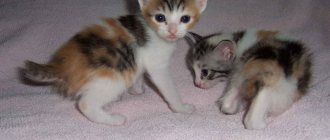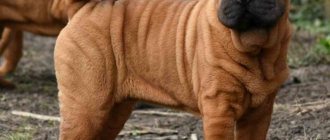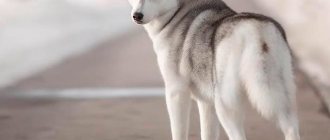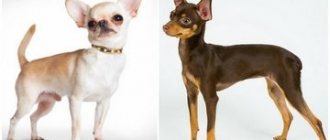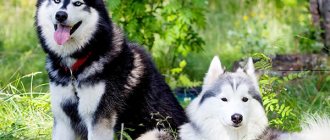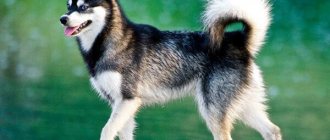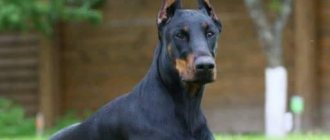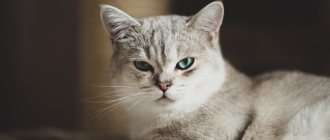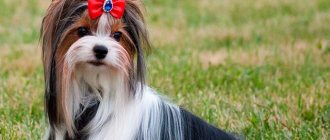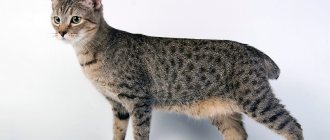Siberian Huskies are a freedom-loving breed of dog, in whose veins flows a mixture of the blood of wolves and northern dogs. The popularity of these blue-eyed dogs is constantly growing, as they are not only a human companion, but also a loyal friend and reliable assistant. In appearance they are similar to a wolf, but their character is friendly and peaceful. This was achieved through long-term selective selection, since the history of the origin of the husky is very mysterious and mysterious. But to understand it, it is worth studying all the stages of formation in order.
The beginning of the history of the origin of the Husky breed
In the area of Lake Baikal, drawings were discovered on the rocks depicting sled dogs. The estimated age of the find is 4 thousand years, but no one can say for sure that these are descendants of huskies. Sled dogs helped nomadic hunters survive in the harsh conditions of Eastern Siberia.
There is an opinion that the breed got its name from the Eskimos, who were called “Eski” for short. Therefore, their dogs began to be called “huskies” on a whim.
In the distant times of the origin of the breed, all sled dogs with a polar color and thick hair were called huskies, without division by species qualities. Subsequently, they began to distinguish a certain category of dogs that had common characteristic features. The energetic dogs were not stronger than the deer, but in terms of endurance they were not inferior to anyone. They could wander for a long time along the snow-covered plains, despite the blizzard and wind, piles of ice and huge drifts. At the same time, their needs for food and rest were minimal.
Brief history of the breed
Siberian sled huskies, bred in Chukotka by indigenous peoples, and sled dogs from North America took part in the creation of modern huskies. The name of the breed comes from a corruption of the word "Huskimos", which was used by sailors from England when referring to the Eskimos.
The main feature of the new breed was the ability to pull a team at high speed. The bred dogs delivered cargo, and the fastest representatives were used to breed them.
Energetic and athletic dogs have:
- erect ears and wedge-shaped head;
- elongated muzzle with a pronounced mask;
- blue, green, yellow, brown or heterochromic eyes;
- curved tail with thick fur;
- rich fur with two-layer wool of gray, copper-red or black color.
The good-natured nature of the husky, which distinguishes it from other aboriginal breeds, allowed it to move away from its working past and become an ordinary companion dog.
Cruel selection
Scientists put forward a version that the history of the appearance of the Husky breed is connected with their hereditary relationship with wolves, as indicated by their external similarity. This is based on evidence that northern dogs constantly mated with wild animals. To do this, their owners specially tied the bitch during estrus to places where wolves hunted. As a result, the bred offspring were used for transportation in sleds.
Subsequently, a cruel selection was carried out, as a result of which aggressive and uncontrollable dogs, in whose veins the blood of wolves predominated, were mercilessly eliminated from the rest. This was a necessary measure, since any ignoring of the pet’s commands could cost the hunter’s life. Dogs that could not cope with their duties were castrated. As a result of such selective selection, only elite dogs could reproduce. This ultimately made it possible to obtain the progenitors of the Husky breed.
Existing varieties and their differences
Aboriginal dogs living in Chukotka still transport cargo, but this tradition is preserved only in some settlements.
Breeders from America and Russia who breed huskies rely on different qualities:
- attractive exterior from the USA, allowing for deterioration in performance;
- working qualities on the part of the Russian Federation, which prevail in importance over the attractive appearance of the animals.
Depending on the purpose of breeding, the breed is divided into 3 varieties:
- Exhibition. The exterior is determined by the kennel club. European representatives have graceful features, while American ones are famous for their massiveness. These dogs have a short muzzle, which gives them an attractive appearance. Due to the narrowing of the nasal passages, thermoregulation is disrupted, which prevents the warming of frosty air. Such dogs are bred exclusively for show careers and are not “workhorses”.
- Racing. They have short fur and long legs, allowing them to develop very high speeds. Their exterior is specific and inferior to show dogs. They are used in harness racing in conjunction with other relatives.
- Workers. They are used to transport goods and people, and are practically no different from their ancestors. They are inferior in speed to racing ones, do not shine with beauty, but have amazing endurance and intelligence.
Despite the fact that the official standard still defines a “working” appearance, deviations towards the exhibition or racing variety are considered acceptable.
The maximum compliance with the standard can be seen among the British.
In addition to classic sledding and harness racing, other sporting events have been invented for modern representatives living within the city:
- hiking, which involves long walks along forest paths with hiking equipment;
- bike joring, which replaced the sled with a bicycle;
- skijoring, which allows only one dog to pull the sled;
- karting, which involves transporting a cart with a person or cargo;
- canicross, where a dog pulls a running person and safety is regulated.
Transport of gold miners
At the beginning of the twentieth century, the Soviet government recognized the uselessness of this breed of dogs, due to their compact size, which did not allow them to transport heavy loads in sleds. The sharp reduction in the number of dogs was also associated with the established ban on feeding fish to dogs, which was their main food.
It is unknown how it would all have ended if the gold rush had not begun in America. This was the impetus for continuing the story of the origin of the husky dog. Americans were able to appreciate the endurance, energy and ease of care of these northern dogs.
Gold miners massively bought the best huskies from the Chukchi and transported them across the strait to Alaska. Already in America, this breed was given the official name “Siberian Husky”, confirming its true origin.
Who are Huskies, what breed?
In short, all varieties that descended from northern dogs that were distinguished by strength and endurance belong to the husky family. It is difficult to call them a separate breed. This is the general name for an ever-changing crossbreed of the fastest sledding breeds.
"Husky" or "husky" is a shortened version of the word "huskimo" ("Eskimo"). This is how the sailors of English merchant ships pronounced the name of the northern people. In the mid-nineteenth century, the dogs that Eskimos and Inuit used in everyday life began to be called the same.
Officially, information about the dog breed was established by the standard in the thirties of the last century. Conventionally, representatives of the breed can be divided into three groups:
- workers;
- racing;
- exhibition
The “oldest” and rarest are working dogs. These are amazingly hardy animals. Racing dogs are athletes with long, well-developed legs. Their main advantage is speed. Exhibition specimens are talented actors with very expressive “faces”. This is a show dog that knows how to “keep a mark” on any audience.
Continuation of the history of the origin of the Husky breed
Over time, a new sport appeared in America thanks to these unusual dogs - sled dog racing. This not only continued the history of the Siberian Husky breed, but also created an unprecedented excitement around these animals. After all, there was a lot of money at stake, which caused the price of the surviving dogs to rise sharply.
As a result, even small dogs (up to 60 cm), which had previously been rejected, began to be imported to Alaska. The last team from eastern Siberia was exported in 1930. The first official breed standard was recognized in America in 1934.
Early representatives of huskies had more than mediocre appearance, for which they received the nickname “mice.” But their endurance and energy completely compensated for this deficiency. Subsequently, the need for sled dogs grew, so the breed was constantly developing. But it was still used purely for work.
This is how the history of the Husky dog breed continued until the first representatives appeared with an unusual blue eye color and a black “saddle” on the back. This served as the start of selective selection for the beauty of the breed and led to its stratification into three types: working, racing and show dogs.
Origin and history
Motherland
It is believed that four-legged northerners are the closest relatives of modern wolves. A common ancestor, the northern wolf, gave them a similar set of DNA genes and a similar appearance.
They say that at first the Eskimos were called this, and then the word became attached to their four-legged friends. According to another version, the dogs earned this name because of their specific bark, reminiscent of a growl - from English husky translates as “hoarse”.
IMPORTANT! Huskies not only look similar to wolves, but are also close relatives in their genes.
The ancestors appeared back in Neolithic times. During their constant wanderings, the inhabitants of the Far North needed a powerful, strong animal that could carry heavy loads. Therefore, Chukchi sled dogs have been bred in those parts for a long time. History has lost the knowledge of who bred the first blue-eyed puppy, so, according to different versions, both the Chukchi and the Eskimos can lay claim to the palm. More precisely, these are different representatives of the same family, which we now call the same. When dogs from the Russian North were brought to the United States for racing, they were given this common name.
In any case, this is a real northern animal that lives well in a big city.
How the breed was developed
There are legends that the famous handsome men are descendants of direct crossing of dogs and wild wolves. The northerners bred them specifically so that the furry animals could move long distances with heavy loads and endure severe frosts down to –60 °C. It was important that they could coexist with people in the plague, not rush at others, and be kind. That is why they can be left to look after small children - four-legged nannies are good-natured and playful, will never bite and will be able to attract the attention of parents if something happens. Dogs are also good because they love company, get along easily and get along well with other animals. After all, up to 15 animals could run in a team, and it was important that aggression not manifest itself in the pack.
IMPORTANT! The character and appearance features were acquired as a result of targeted selection.
Where do they live now?
Not only as mounts, but also as companions, blue-eyed animals became popular in the 1970s. The species is called "Siberian Husky". It was brought to Russia only in 1995. Now representatives are settled all over the world, even in warm regions, but, nevertheless, they feel best in natural conditions close to the northern ones. They need physical activity and long walks, so dogs can live in the city, but the owner will have to try hard with the living conditions. But these friends of man do not like closed spaces, from which they always try to get out: they dig tunnels, gnaw at closed doors. Sometimes they even run away from home, but with good training this feature disappears.
IMPORTANT! With them, sports will become a part of your life. The more exercise, the more fun your energetic pet will have.
Main features
You will never confuse this dog with the others. He has a special expressive appearance, similar to that of a wolf. It is a medium-sized animal with a muscular body and long legs. The head is heavy, medium in size, the muzzle is very similar in appearance to a wolf, with contrasting “glasses”. The nose is shortened, sometimes a “snow spot” appears on it - a pink stripe that appears in winter. The eyes are slightly slanted, almond-shaped, the color varies from brown to blue, heterochromia is characteristic - different eyes. The ears are triangular, set high, and the color ranges from light shades of white-gray to black. Rare - pure white wool. Noticeably distinguished by the fox's tail, gracefully curled over the back, and extremely fluffy paws. Their paw pads are hardened in such a way that they can withstand low temperatures for a long time and run in the snow. This is a freedom-loving, dynamic animal, its appearance speaks of this.
IMPORTANT! The pet's appearance is memorable and striking - especially the blue eyes and wolf-like muzzle.
REFERENCE
- These are dogs with a very ancient history and come from the North.
- They are relatives of wild wolves at the genetic level.
- Distributed throughout the world, ideal company for a family with a child.
- They are good-natured and friendly with all four-legged human friends.
- Outwardly similar to a wolf, it is difficult to confuse with other canine breeds.
Heroic feat
The history of the Husky breed is striking in its variety of facts and interesting incidents. One of them should definitely be mentioned below.
Studying the history of huskies, one cannot help but remember how, thanks to these dogs, an entire city was saved from diphtheria. This event occurred in 1925, when an epidemic broke out in the city of Nome, which endangered the lives of many children. Only a special serum that had to be delivered from Anchorage could save them. Bad weather conditions did not allow this to be done by plane. Therefore, it was decided to bring the necessary vaccine by dog sled, despite the distance of 1000 km, snow drifts and severe blizzards. For this purpose, the best representatives of the husky breed were selected.
On the way, something unexpected happened - the person driving the team was paralyzed as a result of severe frostbite. And then the leader of the dog pack, Balto, took control, who realized that the owner was feeling bad and needed to be taken to a populated area. Thanks to the dogs' endurance and energy, the vaccine arrived in Nome on time, which saved the children's lives.
In gratitude for this act of the husky, the image of Balto was immortalized in the form of a monument, which was erected in the Central Park of New York, and became the national treasure of the American people. Until now, the heroic history of the husky is studied in schools and serves as a symbol of endurance, valor, and honor.
Husky in Alaska
The breed would probably have disappeared that way, but it’s time to shift the chronology of my story to an earlier time. In 1880, gold was discovered in Alaska. I think it’s easy to guess that a huge number of seekers of this wonderful metal immediately rushed there. Not everyone was lucky, as enthusiasts immediately faced the very mundane question of transportation. Particularly savvy seekers realized that they needed to look for suitable dog breeds for sleds. Moreover, those who, due to their origin, are able to cope with transportation in the northern lands.
Such a helper breed was sought out experimentally. And at first, mainly from individuals whose origin was local. There were even sled competitions, whose owners felt real pride.
In 1907, an entire club dedicated to dog breeding was even organized in Nome.
Around this period there was a turn in the history of the Huskies. William Gusak, a fur trader from Russia, brought these dogs from the Siberian lands. Not only a puppy, but also an adult representative of it, as I already said, is quite small. At first, this breed was even called “Siberian mice.”
However, the origin of the dogs quickly made itself known, and they found fans. One of them was Foke Maul Ramsey, an athlete and gold miner. He was so delighted that he even organized an expedition to Siberia in order to obtain these wonderful dogs. At the same time, interest in harness racing increased. Lighter harnesses and sleds were specially designed - just what a husky needs!
Characteristics of the breed
Many livestock breeders are interested in the history of Siberian huskies. The breed was classified in FCI Category 5, which includes primitive, Spitz-type dogs. Their purpose is still unchanged - riding.
According to the generally accepted standard, huskies are characterized by a harmonious physique with developed muscles and strong bones. Males are larger than females. The height of an adult dog at the withers reaches 50-60 cm, and the weight is 23-28 kg. Exceeding these indicators is a disqualifying fault, therefore these dogs are not allowed for further breeding.
The husky's front legs are long, straight and wide-set, and the hind legs are characterized by powerful muscles from the hip. The pads on the limbs are fully adapted to walking on snow, they are tightly compressed, so they do not need to be cleaned after a walk.
The tail is of medium length and strong. The breed standard does not allow the tail to be thrown over the back or curled into a ring. It should be raised with a sickle or lowered low.
The head is of medium size, the features of the muzzle indicate a relationship with wolves. The ears are triangular in shape, medium in size, deep set, and rounded at the tips.
Husky eyes are slanted, their shade can be blue or brown. Heterochromia, when the iris of the eyes has a different color, is not uncommon.
Husky character
Husky photo
Each breed has its own personality traits. They are determined by the purpose for which it was bred and used. For huskies, this means transporting goods in harsh weather conditions. Thanks to this, the following character traits have developed:
- complete absence of aggression towards the owner and other dogs;
- high mobility and performance, the desire to constantly move;
- devotion and affection to one owner;
- intolerance of loneliness, they need communication;
- unpretentiousness and good adaptability.
One of the advantages of this pet is its love for children. He treats them with care, even if they inadvertently caused them pain. Never bites or growls. Northern peoples used to use these animals to warm babies. Now this dog will become a devoted and caring friend for a child. The pet accompanies him everywhere, plays, and does not let anyone offend him.
This is a companion dog, more suitable for the role of a friend. Not suitable as a security guard or watchman. She has no aggression, and has not developed the instinct to protect the territory. It will only protect its owner from those who behave aggressively. And a calm thief can be greeted kindly.
Husky muzzle
These animals are not used as hunting animals, although they have long been able to obtain their own food. They have a hunting instinct, but they do not bring prey to the owner. They also cannot become a service dog, since they are very independent and will not immediately follow all orders.
These animals really need long-term physical activity. You need to walk them a lot, preferably running and playing. If the pet is not tired, it will misbehave at home. The main reason for things to get damaged is boredom.
The character flaws of these dogs include willfulness, stubbornness, and independence. They are used to making decisions on their own and being on an equal footing with a person. Males are very freedom-loving and strive for dominance, while females are cunning and resourceful. Because of these character traits, running away is a common problem. Huskies do not like to stay at home for a long time; they can break glass and quickly figure out how to open the latch. But they often run away from the yard - they can jump over a high fence or dig under a hole.
Coat type and color
The guard hair of the coat is characterized by medium length and soft structure. It fits tightly to the body, so the lines of the silhouette are clearly visible.
The undercoat is dense, but during the molting period it may be completely absent.
There are about 20 different colors of this breed, and the characteristic “mask” is not a standard sign of purebredness.
The most common Husky color is gray-white or silver-white with a cool undercoat. A rarer pigment is chocolate, brown, red. The most impressive looking are gray huskies, which are most similar to wolves.
The exception is merle, sable, piebald, black, and white wool pigments. Therefore, such huskies are much more expensive.
Varieties of color
A short list of color options:
- Black. Absolutely black color is rare. There may be patches of white on the muzzle, chest, paws and tip of the tail.
- White. Rare snow-white color. The undercoat and coat are the same white color.
- Black and white. Approximately equal parts black and white wool. The undercoat is either completely black or snowy white. The upper part of the body is “filled” with black from the back of the head to the tail. The paws, chest, and belly are predominantly white.
- Grey. A common species with a gray coat and a silver, cream or beige undercoat.
- Silver. Cool color without interspersing warm tones. The undercoat is silver to snow-white, the coat is light gray to silver.
- Copper or chocolate. Rich chocolate tone with a copper tint.
- Ginger. The overall tone is lighter than chocolate. A pronounced red color, similar to a fox fur coat.
- Pale yellow. Warm pastel tone from light brown to fawn. The undercoat is also fawn or light cream. A reddish tint is unacceptable.
- Wolf grey. Warm gray tones interspersed with red, fawn or yellow. The undercoat is only beige.
- Sable. A very rare color with a bright copper undercoat. Each hair is beige-fawn at the root and dark gray or black at the end.
- Agouti. Shades from gray to deep black. Possible stripes. The undercoat may have a warm creamy tint. There are reddish areas on the paws. A distinctive feature is the black tip of the tail and a dirty dark “mask” on the muzzle.
In addition to the listed combinations, there are Isabella, saddle, black and tan, Splash Coat, piebald, harlequin and other color options.
Character
Dogs have high intelligence and intelligence. But this is often questioned due to the pet’s difficult learning curve. But this is an erroneous opinion, since this breed does not need banal training, but the pet’s interest during the learning process.
Sensing a strong leader in their owner, they quickly master all the necessary skills and develop habits.
Despite their stubbornness and willfulness, huskies are very friendly and friendly. These dogs get along well with all family members, and especially love children. Husky mothers are very caring towards their offspring.
Huskies are not suitable as a guard dog, since they not only do not show aggression towards a stranger, but can also lick him as a greeting.
How to choose a puppy, who is better - a boy or a girl?
Young ladies are recognized leaders. They are tougher and faster than boys, but they have to put up with a difficult character. Boys are more powerful and more passionate, they are better suited for sports. The appearance is also important: cynologists do not recommend the Alaskan Malamute for living in an apartment, and the small Klee Kai was bred precisely for this purpose.
The decision also depends on the purpose for which the pet is purchased. A girl of pure breed can bring considerable income, since Siberian Husky puppies are in demand. And a boy of average condition is most often castrated.
Training and education
It is necessary to start raising a Husky from the first day this dog appears in the house. This will allow you to accustom your wayward dog to basic commands. At the age of six months, it is recommended to entrust the pet to a professional dog handler who can direct the dog’s stupid energy in the right direction.
If this is not possible, training should be carried out independently. In this case, you should adhere to the following recommendations:
- One line of education. All family members must adhere to the same line of behavior, otherwise the dog will not be able to understand why he is either praised or scolded for the same thing.
- The use of physical punishment is unacceptable. Carrot and stick behavior is not acceptable with Huskies. When completing tasks, the dog should be rewarded with a treat, and if it is not completed, its attention should be switched.
- Multiple repetition of commands. You can achieve precise completion of a task only by repeating it several times a day. At the same time, the owner’s task is to interest the pet in performing them.
- Increased physical activity. Judging by history, Siberian Huskies have high endurance. And in the absence of great physical activity, their energy is destructive. Therefore, the more the dog exercises, the healthier and more active he will be.
Tips for choosing a puppy
Before buying a bundle of joy, you should evaluate your physical and financial capabilities. Given the popularity of the breed, not only purebred dogs are offered for sale, but also “amateur-bred” Siberian Husky puppies. If you want to take a risk and buy a dog with a high tendency to genetic abnormalities and an unstable psyche, go to the market and buy a pet at half price from the first merchant you come across. Naturally, this option will not suit a responsible owner; it is better to take a puppy from the street, save a life and not spend a penny. However, the following question arises: how to choose a Siberian Husky puppy from a breeding litter with such a wide range of options? Here are some tips:
- Decide what type of temperament you need - a hard worker, an athlete, or a handsome domestic dog. By the way, working dogs are increasingly sold in the “pet” rank, which means you can buy a full-fledged dog for a relatively modest price. Naturally, a show-class dog is purchased for exhibitions. The sports type is suitable for active owners, provided that you do not intend to change your lifestyle for the next 12–15 years.
- Is color important to you? If yes, book your puppy in advance, since blue-eyed dogs are purchased first.
- Origin – for show work, it is better to purchase a puppy in the USA or in elite nurseries. For home and sport, only two factors are important: the reputation of the breeder and the health of the puppy, and not the “roots” of the producers.
- Who is more loyal? Bitch or male? Huskies, regardless of gender, are very active and, with a lack of exercise, can show inadequacy in terms of obedience and affection.
- Why do you need a dog - joint leisure? Then husky. Security or hunting - buy Laika. By the way, the differences between the Siberian Laika and the Husky are so contrasting that it is almost indecent to compare these breeds. The four-legged dogs are a little similar in appearance, but Laikas are full-fledged service dogs, and Siberian Huskies have long “migrated” to the show class.
Health
Huskies are distinguished by good health. But there are diseases to which they are most susceptible.
Types of pathologies:
- Hip dysplasia. The disease negatively affects the dog’s entire musculoskeletal system, which prevents him from moving normally. To eliminate the pathology, medication and physical therapy are prescribed.
- Juvenile cataract. Consolidation of the pupil, which reduces visual acuity. Develops before the age of two years. It can only be eliminated surgically.
- Retinal atrophy. Dystrophic changes in the retina, which lead to complete blindness. It often affects both eyes at the same time.
Rules of care
According to the history of the breed, huskies are not demanding in terms of living conditions. Caring for them comes down to following standard rules:
- Feeding. Despite their natural endurance, huskies suffer from a weak stomach, so their diet should be enriched with protein and fatty foods. When choosing dry food, you should pay attention to premium products, since cheap food does not contain the necessary amount of vitamins and minerals for a dog’s health. When feeding natural products, the husky's diet should include beef, veal, poultry, sea fish, offal, vegetables, and fruits. You also need porridges that can be steeped in boiling water without further preparation.
- Grooming. The coat should be brushed once a week. But during the molting period, which occurs twice a year, this procedure should be carried out regularly once a day. You should wash your pet no more than once a month.
- Eye cleaning. This procedure is carried out as needed when dust, debris, or discharge collects in the dog’s eye. You should rinse your eyes from the outer corner to the bridge of your nose with boiled water.
- Teeth cleaning. The procedure should be done when plaque or tartar appears. In the first case, you can use a special brush and paste, which are sold in a pet store. In the second case, the cleaning is carried out by a veterinarian.
- Ear care. You should wash your ears as they become dirty no more than once every 2 weeks. To do this, it is recommended to soak a cotton pad in boiled water, squeeze out excess liquid and gently wipe the ears.
- Walks. Huskies are not meant to live in an apartment; they need a house with a yard where they can feel at ease. In addition, the dog needs to be walked twice a day, for at least 20-30 minutes. In this case, the walk should be active with increased physical activity.
Cost of husky puppies
The average cost of a dog without a pedigree in Russia is 6-10 thousand rubles. It is fashionable to find cheaper options “from hand”, but this is risky: the state of health, the presence of vaccinations and the necessary skills are often confirmed only by the words of the seller.
Cost of some purebred species (in dollars):
- Siberian – up to 1,000;
- Alaskan – 3,000-10,000;
- Klee Kai – up to 8,000;
- Japanese (Akita Inu) – 600-800.
In a nursery, a child from ordinary parents can cost 20-30 thousand rubles, and a descendant of champions can cost 40-50 thousand rubles.
Advantages of the breed
Before making your final choice, it is worth considering the main advantages of a husky:
- High level of intelligence and intelligence.
- Friendly towards all family members and other pets.
- Increased care for your offspring.
- The wool does not have the characteristic dog smell.
- Endurance and high level of immunity to common diseases.
- Unpretentious in care.
- He eats little.
- They are not dominant, so they rarely come into conflict with other dogs.
Pros and cons of the Siberian Husky
The positive aspects of the Siberian include:
- friendliness;
- sociability;
- friendliness;
- excellent health;
- endurance;
- ability to make decisions in difficult situations.
The Siberian Husky is different in that it does not have a dog smell. In addition, this is one of the most beautiful dogs.
Flaws:
- sheds profusely and frequently;
- not suitable for protecting the territory;
- loves to dig the ground, spoils flower beds;
- needs long walks.
When starting such a breed, it is necessary to take into account its characteristics, so as not to be disappointed in the acquired four-legged friend.
Flaws
In addition to the advantages, there are also certain disadvantages, which is due to the history of the Husky breed:
- They prefer to pull on a leash when walking, as they are sled dogs.
- Instead of loud barking, huskies prefer to howl, which indicates their origin.
- They are stubborn and willful, which makes parenting difficult.
- Not suitable as guards.
- Need increased physical activity.
- Not suitable for keeping in a booth or small apartment.
- They need special training.
Having studied the history of the Husky breed, you can understand that this type of dog has irrepressible energy, the ability to survive in harsh conditions and perseverance in achieving goals. Therefore, in order to curb such a pet, you need to have enough strength and perseverance, otherwise this northern pet will establish its own rules in the house.
Popular varieties of husky
The scientific description of the pet is quite dry: a strong straight back, a chest of medium width, a slightly sloping croup, strong limbs. But can this portrait convey the charm of an intelligent and friendly dog?
The most popular types:
- Siberian (medium breed, companion).
- Alaskan (mixed breed, half husky, half malamute, bred for sled dog competitions).
- Klee Kai (“apartment” pet, companion, watchman).
- Sakhalin or Shiba Inu (large breed, hunter, companion).
- Japanese or Akita Inu (guard, not suitable for running).
- Samoyed dog (show breed, companion).
- American Eskimo (“apartment” dog, guard).
All species are distinguished by their good disposition, very attractive appearance, unique style and high intelligence.
Siberian
Contrary to their name, Siberian Huskies come from the northern regions of America. They were bred from the East Siberian sled dogs brought to Alaska in the nineteenth century and the local hardy Indian dogs. These were the times of the Gold Rush, when people needed strong and reliable companions. The first standard was adopted in 1930, but the breed received recognition from the FCI (Federation Cynologique Internationale) only in 1966.
Akita Inu
Akita Inu is called the Japanese Husky. This breed was bred on the island of Honshu in the Akita province. The animal's ancestors were used to hunt large animals (boar, deer, bear). Now the breed is considered semi-functional (not quite a hunter, but on occasion it can). The impressive size of the dog is suitable for the role of a guard, but his good-natured nature does not allow him to perform such work.
Alaskan
The Alaskan Malamute is the fastest, largest and most powerful representative of the breed, capable of running at speeds of more than 30 km/h for three days. The species was not bred in Siberia, but in Alaska. This is the most expensive mestizo in the world. It has dense short hair. They treat people with love and respect, are curious and playful.
Klee Kai
This is a relatively “young” breed, bred in the 70s of the last century by American breeders. Husky and Spitz mixes are small in size and have short hair of black and white, white and gray or red and white color. The Klee Kai was bred as a companion and watchdog. This is a beautiful little "apartment" breed.
Husky Samoyed
Large fluffy huskies (Samoyed, Samoyed, Sammy) are native breeds. Outwardly they are very reminiscent of a polar wolf. At the end of the nineteenth century, several individuals of northern dogs were brought to England from Siberia and the Urals, which became the founders of the European breed. There are now seven breed standards for the Samoyed: English, International (FCI), Canadian, New Zealand, South African, Australian and American.
American Eskimo
The American Eskimo dog was obtained in the USA from a cross between a native species and a German Spitz. Most often, the dog is completely white, covered with very thick hair. “American” is not large in size, suitable as a pet, and takes on the work of a watchman and security guard. Can be used as a watchdog (drug detection) and takes part in sports competitions.
Agouti
Agouti is the name of the phenotypic color of the dog, not a separate variety. This word denotes the specific name of a small rodent with brown-gray fur. The origin of the “Agouti gene” is associated with primitive breeds, northern sled dogs. Based on this material, new species with black, gray, yellow and red wool were bred.
Sakhalin
The Sakhalin Husky is a Japanese sled dog whose origins are related to the Akita Inu and the Japanese Spitz. The view is very unpretentious. The dog is devoted to his owner, but loves freedom - he strives to escape at the first opportunity. An obedient dog loves his owner, recognizes him as the leader of the pack, but as soon as he gives in, he immediately “goes on the run.”
